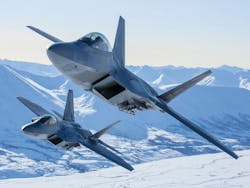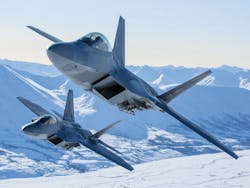Five companies to design power and thermal management for future jet fighters
WRIGHT-PATTERSON AFB, Ohio - Military aircraft engine designers at the Boeing Co. are joining a major U.S. Air Force project to design next-generation aircraft power-control and thermal-management systems to enable future jet fighter aircraft to accommodate new technologies like laser weapons, powerful electronic warfare (EW), and low observability.
Officials of the U.S. Air Force Research Laboratory at Wright-Patterson Air Force Base, Ohio, announced a seven-year contract to Boeing Defense, Space & Security in Hazelwood, Mo., for the Next Generation Thermal, Power, and Controls (NGT-PAC) program.
Boeing joins the General Electric Co. (GE) Aviation segment in Cincinnati; the Northrop Grumman Aerospace Systems segment in Redondo Beach, Calif.; the United Technologies Corp. Pratt & Whitney division in East Hartford, Conn.; and the Lockheed Martin Aeronautics segment in Fort Worth, Texas, for the NGT-PAC program.
Engineers from the five companies will share as much as $409 million in carrying out research to prove the technological feasibility of new kinds of thermal, power, and controls components and architectures using existing airframe and engine designs as test beds.
Next-generation fighter aircraft will require an unprecedented level of advanced capabilities for air superiority in contested environments. These capabilities will include advanced electronic attack, high-power laser, and future low-observability features. These advanced technologies are expected to require as much as 10 times the power levels of current tactical systems, Air Force experts say.
These power demands present electrical and thermal challenges aboard aircraft - especially in the presence of composite aircraft skins, high-efficiency engines, and embedded vehicle systems. Experts from the five companies will try to better understand the challenges and opportunities of and advance the state of the art in next-generation aircraft thermal, power, and controls.
Experts will focus on two areas: aircraft engines and airframes to develop revolutionary aircraft power, thermal, and controls technologies.
On these contracts Boeing will do the work in Hazelwood, Mo.; GE in Cincinnati; Northrop Grumman in Redondo Beach, Calif.; Pratt & Whitney in East Hartford, Conn.; and Lockheed Martin in Fort Worth, Texas. All five companies should be finished by July 2024.
FOR MORE INFORMATION visit Boeing Defense, Space & Security online at www.boeing.com; GE Aviation at www.geaviation.com; Northrop Grumman Aerospace Systems at www.northropgrumman.com; United Technologies Pratt & Whitney at www.pw.utc.com; and Lockheed Martin Aeronautics at www.lockheedmartin.com/us/aeronautics.html.

